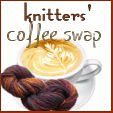Easy? Intermediate? Advanced?
I thought I'd take some time in my post today to discuss something that's been weighing on my mind for some time. My usual updates about my daily adventures will resume later in the week.
I love going through knitting and crochet books. I'm not saying that I necessarily have to buy them - but I love looking at patterns. I love stopping in a Barnes and Nobles to check out their craft section, and I love getting knitting and crochet books from the library. I know that I'm certainly not alone in this. But, when looking at these pattern books, I've noticed something a little frustrating.
You know - that little (sometimes present) subtitle that tells you whether the pattern is for beginner, intermediate, or advanced knitters or crocheters. So, here's the frustrating part - what exactly does that mean? Have you noticed that certain books or magazines will have different criteria as for what is easy and what is more difficult? For example, in one knitting book, a simple drop-sleeved sweater knit totally in stockinette (except maybe for some ribbing at the bottom) was given a rating of 5 - meaning it was very hard. However, in another book, that very same sweater would be considered easy. Does this drive anyone else crazy?
With knitting, I pretty much get what makes an advanced pattern. Usually it's something that includes a complicated cable pattern that requires you use a chart, or maybe a tricky intarsia or fair isle pattern. What becomes more difficult is distinguishing between what one pattern designer might consider easy vs. intermediate. Usually this involves some sort of shaping to be considered intermediate but not always.
However, with crochet, I'm still completely confused. I can't figure it out at all. Again, some books will consider anything other than a scarf advanced while others use more subtle criteria. Specifically, I've been a little stumped by this book I got from the library, Cool Crochet. It has some very lovely patterns - but it seems like all the ones that I want to do are for experienced crocheters. Yet, I can't figure out why those patterns are advanced - they don't use any charts, they don't use any crazy color combinations, they don't use any fancy stitches. Yes, there's shaping but that can't be all because there are other patterns in that book for garments with shaping that are labelled advanced beginner. Advanced beginner??!! As if that doesn't create even more confusion! (Note: I do not mean to just single out this one book - just about every knitting or crochet book do the same type of thing - Cool Crochet just came to mind because I just got it from the library)
So, I guess the other alternative would be to follow the likes of Debbie Stoller (Stitch n Bitch) and the crew at Interweave Knits who don't include any indication of how difficult a pattern is. In one sense this is a good thing because it doesn't discourage people from going outside of their comfort zone. But, on the other hand, I think it's also useful to know what one is getting into when starting a pattern.
I wish I had some sort of solution. It would be very nice and thoughtful if all of the publishers and pattern designers could come up with a standard set of guidelines regarding pattern difficulty. But, that probably won't happen any time soon. Until that time, if you design patterns, why don't you let us know why you've designated something as easy, intermediate, and advanced? Maybe that way we can all start speaking the same language.
Any thoughts on this?
Ok - my thought piece is done for the day! As I mentioned before, a more "normal" posting will resume later in the week.








3 Comments:
I agree..I've gotten into the habit of just going with the one I like and relying on my yarn store friends to help determine if the stitch pattern is hard. Another way to look at is if you understand the pattern forge ahead!
Figuring out all the different skill levels can be frustrating . . . but like Amy I also rely on my lys and my knitting pals to help me . . . hey sometimes we are all stumped! I just make what I like or what I would want to get.
Crochet cant even agree on terms between US and UK. Thing as simple as double crochet are different.
Post a Comment
<< Home